Living bacteria are essential to transform your kimchi from raw vegetables into a tangy, complex fermented dish. You'll find naturally occurring lactic acid bacteria (LAB) like Leuconostoc and Lactobacillus on the cabbage leaves, ready to convert sugars into lactic acid. These beneficial bacteria thrive in the salty environment you create, multiplying rapidly to break down carbohydrates and produce the signature acidic flavor. They're also your natural preservatives, creating an environment where harmful bacteria can't survive while developing kimchi's distinctive taste. The fascinating interplay of these microscopic workers reveals an even deeper story of traditional Korean fermentation.
Understanding Lactic Acid Bacteria
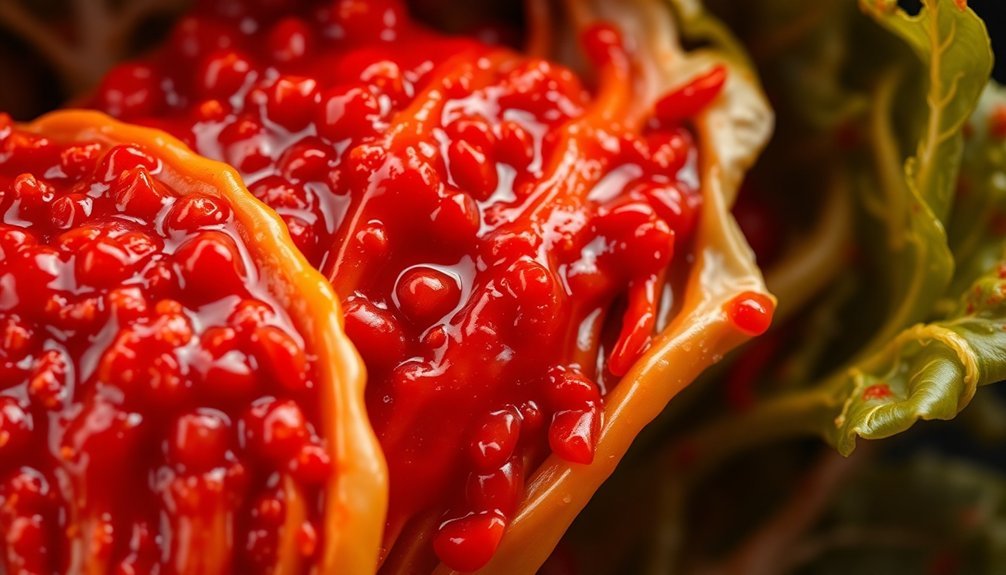
For centuries, lactic acid bacteria (LAB) have played an essential role in food fermentation, particularly in Korean kimchi. These remarkable microorganisms come in two main shapes: rod-like bacilli or spherical cocci. When you're making kimchi, you'll find that LAB are particularly well-suited for fermentation because they can thrive in acidic environments where other bacteria can't survive.
What makes LAB especially effective is their ability to convert carbohydrates into lactic acid, which serves as a natural preservative. They don't need oxygen to function, and they'll actively produce various compounds that help protect your kimchi from harmful bacteria. One of their most important protective compounds is nisin, a bacteriocin that has been used as a food preservative since 1951. These include organic acids, hydrogen peroxide, and specialized antimicrobial substances called bacteriocins.
You'll find that LAB aren't just good at preserving food – they're also completely safe for consumption. They've earned GRAS (Generally Recognized as Safe) status because they're naturally present in many foods and contribute to a healthy gut microbiome.
As these bacteria work their magic in your kimchi, they're not only creating those distinctive flavors you love but also producing beneficial compounds that can enhance your immune system and improve your digestion.
The Science Behind Kimchi Fermentation
Immerse yourself in the fascinating science of kimchi fermentation, where diverse microbial communities work together to transform simple vegetables into a complex, flavorful dish.
The process begins when naturally occurring bacteria from cabbage, radishes, and garlic start breaking down carbohydrates into simple sugars. The initial salting of cabbage helps create the perfect environment for beneficial bacteria to thrive.
You'll find that the key players are lactic acid bacteria, including Leuconostoc, Lactobacillus, and Weissella. These microorganisms produce various compounds like lactate, acetate, and CO2, which give kimchi its characteristic tang and fizz.
When you maintain the temperature between 50-70°F (with 65°F being ideal), you'll achieve the perfect balance of flavors and textures.
The fermentation process creates a chemical cascade where bacteria metabolize sugars into lactic acid, lowering the pH to around 4.2. This acidic environment not only preserves your kimchi but also develops those distinctive cheesy and fishy notes you'll come to recognize.
To maintain quality, you'll need to store your kimchi in a sealed container and move it to the refrigerator once fermentation begins. Remember, cooler temperatures slow down the process, while warmer ones speed it up.
Salt's Role in Bacterial Growth
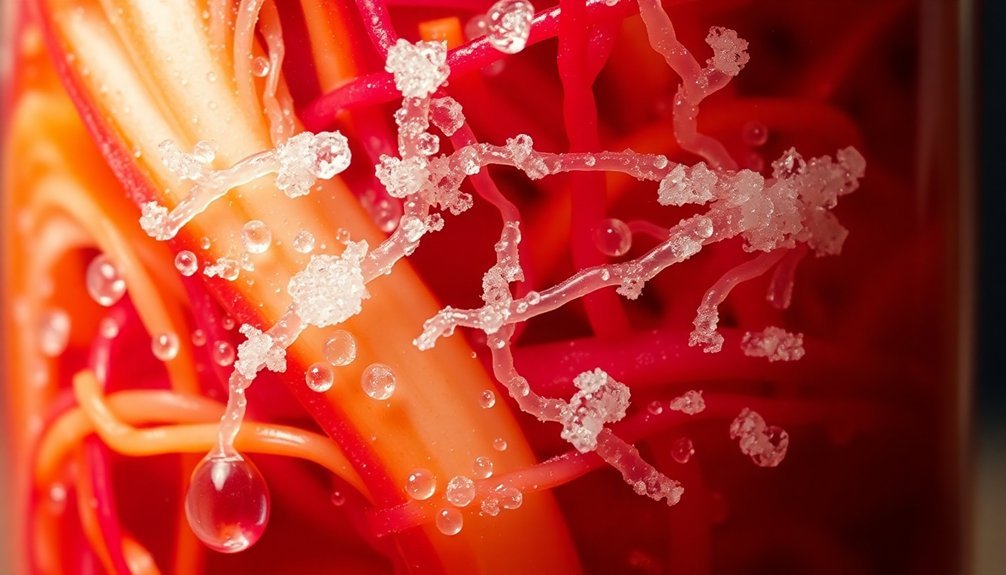
Salt plays a fundamental role in the microbial symphony of kimchi fermentation. When you add salt to your vegetables, it creates an environment where beneficial bacteria can thrive while harmful microorganisms are kept in check. The salt draws moisture from the vegetables, creating a brine solution that acts as a natural preservative and supports the growth of Lactic Acid Bacteria (LAB). Lactic acid bacteria produce characteristic sour flavors during fermentation.
You'll need to maintain a salt concentration between 2-5% for ideal fermentation. This precise balance is essential because too little salt can allow unwanted bacteria to flourish, while too much will inhibit the beneficial LAB activity. The salt controls water activity through osmotic pressure, creating conditions where Lactobacillus and Leuconostoc bacteria can produce lactic acid effectively.
As these beneficial bacteria convert sugars to lactic acid, they're lowering the pH of your kimchi, making it increasingly hostile to harmful microorganisms. The salt's ability to manage osmotic pressure and water activity guarantees that your fermentation process favors the development of probiotics while maintaining the structural integrity of your vegetables.
This delicate balance of salt concentration ultimately determines the success of your kimchi fermentation.
Optimal Temperature for Bacterial Activity
Managing temperature is essential for your kimchi fermentation, with the sweet spot falling between 60° F (16° C) and 70° F (21° C).
You'll get the best results at 65° F (18° C), where beneficial bacteria like *Lactobacillus* and *Leuconostoc* thrive and create complex flavors.
If you let temperatures drop below 60° F (16° C) or rise above 70° F (21° C), you'll risk problems like slow fermentation and mold growth on the cold end, or overly rapid fermentation and strong odors on the warm end.
Temperature Zones For Fermentation
Three distinct temperature zones play an essential role in kimchi fermentation, with the perfect range falling between 55°F and 75°F (13°C to 24°C).
When you're fermenting kimchi, you'll find that each temperature zone creates unique characteristics in your final product.
In the lower zone, below 55°F (13°C), fermentation slows considerably. While this might preserve crunchiness, you'll risk unwanted bacterial growth and potentially compromised flavor development.
The middle zone, around 65°F (18.3°C), provides ideal conditions for balanced bacterial activity and complex flavor development. You'll achieve the best results in this range, as it allows Lactobacillus species to thrive while maintaining proper fermentation speed.
The upper zone, approaching 75°F (24°C), speeds up fermentation but can lead to over-fermented kimchi with excessive funkiness. If you're monitoring your kimchi's progress, you'll notice faster changes at these higher temperatures.
To maintain control over your fermentation, you should store your kimchi in a well-ventilated area at room temperature initially, then move it to refrigeration once it reaches your desired tanginess and texture.
Balancing Cold And Heat
Striking the perfect balance between cold and warm temperatures is essential for ideal bacterial activity in kimchi fermentation. You'll want to maintain temperatures between 50°F and 70°F (10°C-21.1°C), with 65°F (18.3°C) being the sweet spot for optimal flavor development.
When you ferment kimchi at warmer temperatures, you'll notice faster fermentation dominated by Lactobacillus species, creating more complex flavors and increased pungency. At 20°C, your kimchi will ferment in just two days, but you'll also get more volatile compounds and higher acidity.
If you're aiming for milder flavors, cooler temperatures promote Leuconostoc species, though the process will take longer – up to 35 days at 4°C.
To achieve the ideal pH of 4.2-4.5 and balanced flavor profile, you'll need to monitor your fermentation temperature carefully. At room temperature (around 68°F/20°C), you'll get a good balance of mellow fishy and cheesy notes.
However, if temperatures rise above 70°F (21.1°C), you risk excessive carbon dioxide production and overly strong flavors, while temperatures below 50°F (10°C) might lead to incomplete fermentation and potential mold growth.
Primary Sources of Beneficial Bacteria
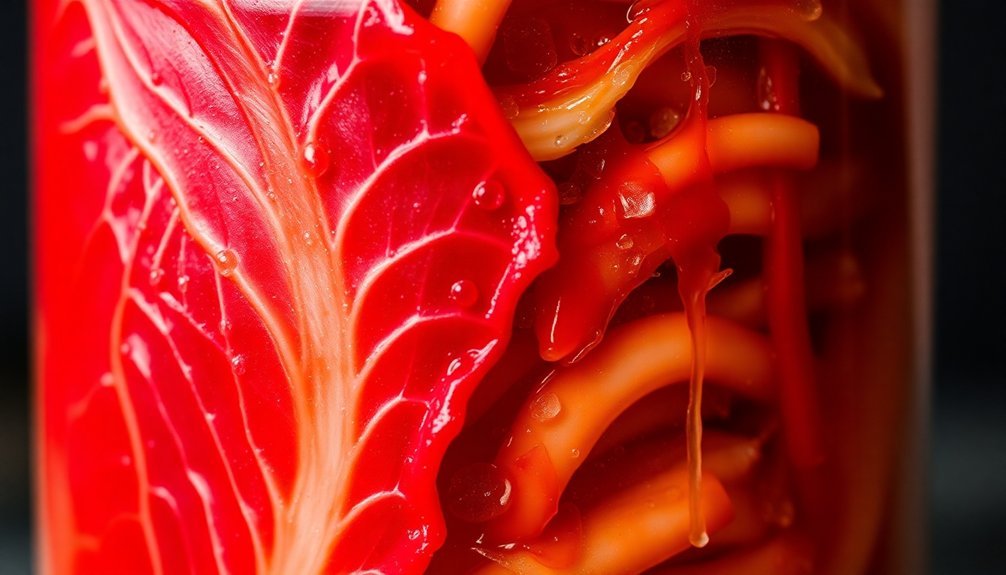
Beneficial bacteria in kimchi originate primarily from the raw vegetables used in its preparation. When you start with fresh cabbage, radishes, and garlic, you're introducing natural lactic acid bacteria (LAB) that will drive the fermentation process.
While these vegetables initially contain low numbers of LAB, the brining process creates perfect conditions for these beneficial bacteria to multiply. The salting process is essential as it draws out water from the vegetables and creates an environment where LAB can thrive while harmful bacteria are suppressed.
You'll find that during brining, the LAB count increases four-fold, setting the stage for successful fermentation.
Key sources of beneficial bacteria include:
- Cabbage, which harbors natural LAB species like Leuconostoc and *Lactobacillus*
- Radishes and garlic, contributing their own unique microbial communities
- Red pepper powder, which enhances the growth of specific LAB species
- Fermented fish sauce (jeotgal), introducing beneficial strains like Weissella koreensis
When these ingredients come together, they create a complex microbial ecosystem that transforms simple vegetables into probiotic-rich kimchi through controlled fermentation under anaerobic conditions.
Creating the Perfect Bacterial Environment
Creating an ideal environment for bacterial growth requires careful attention to multiple variables that influence kimchi fermentation.
Temperature plays a vital role – warmer environments speed up fermentation, while cooler temperatures slow it down. You'll want to maintain specific temperature ranges, with 4°C favoring Leuconostoc species and 10°C promoting more diverse lactic acid bacteria.
Salt concentration is another important factor you'll need to balance carefully. Higher salt levels help inhibit unwanted bacteria while allowing beneficial lactic acid bacteria to thrive, though this will slow down your fermentation process.
You'll also need to guarantee proper anaerobic conditions, as these bacteria perform best without oxygen.
Your ingredient choices greatly impact the bacterial environment. The main vegetables you select will influence which bacterial species dominate, while additions like red pepper powder and fish sauce can alter the bacterial community composition.
When you're preparing ingredients, proper brining and rinsing procedures are essential – they help establish the right initial bacterial counts.
Remember that fermentation duration can vary from days to weeks, depending on how you manage these environmental factors.
Microorganisms in Traditional Korean Kimchi
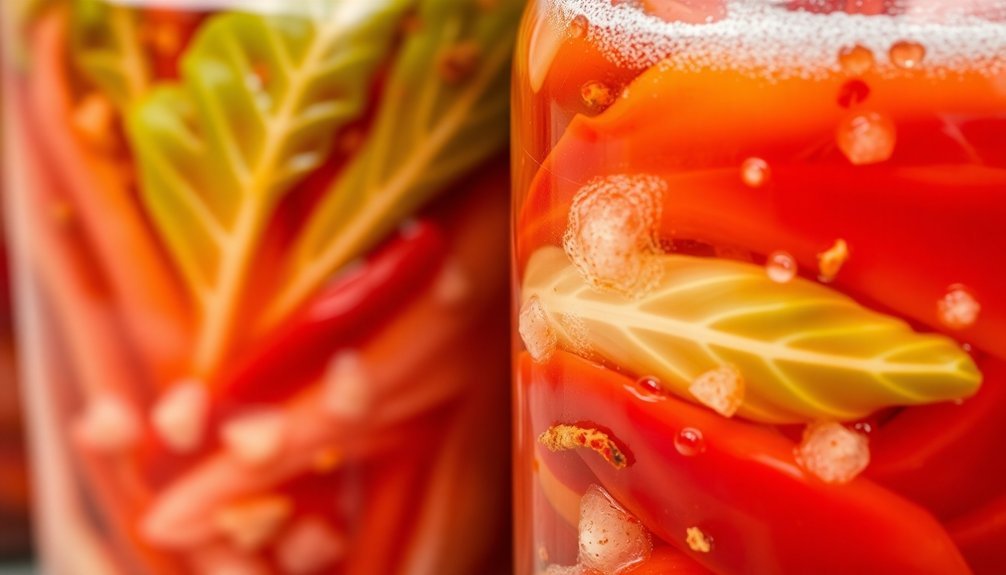
Traditional Korean kimchi relies on several key bacterial species, including Lactobacillus, Leuconostoc, and Weissella, which work together to create the characteristic flavors and textures.
You'll find that these microorganisms naturally occur on the vegetables used in kimchi, eliminating the need for a starter culture.
The salt concentration in your kimchi plays an essential role in determining which bacteria dominate the fermentation process, with higher salt levels favoring Lactobacillus and Weissella species, while lower concentrations promote Leuconostoc growth.
Key Bacterial Species Present
Throughout the complex process of kimchi fermentation, two primary bacterial groups – Lactobacillus and Weissella species – drive the transformation of raw vegetables into tangy, probiotic-rich kimchi. These bacteria naturally occur on the vegetables, particularly cabbage, and work together to create the ideal fermentation environment.
You'll find that Lactobacillus species are especially important as they consume the sugars present in vegetables and produce lactic acid, which gives kimchi its distinctive tang and tender texture. Weissella species complement this process by helping achieve the best pH level of around 4.2, guaranteeing proper fermentation and preservation.
When you're making kimchi, you're relying on several natural bacterial sources:
- Fresh cabbage provides the primary source of lactobacilli needed to start fermentation
- Garlic contributes additional beneficial bacteria to the microbial community
- The combination of ingredients creates a diverse bacterial environment
- Environmental factors influence the final bacterial composition
While individual ingredients like cabbage and garlic contain beneficial bacteria, it's their combination that creates the complete microbial community necessary for authentic kimchi fermentation.
The interaction between these bacterial species guarantees the development of kimchi's complex flavors and probiotic benefits.
Salt's Effect on Microorganisms
The precision of salt concentration plays a pivotal role in managing microbial growth during kimchi fermentation. You'll find that salt creates an ideal environment by drawing moisture from vegetables to form a brine solution, which selectively promotes beneficial bacteria while inhibiting harmful ones.
When you're making kimchi, you'll need to maintain a salt concentration between 2-5% for effective fermentation. This balance guarantees that lactic acid bacteria (LAB) like Lactobacillus and Leuconostoc can thrive while producing enough lactic acid to lower the pH and prevent spoilage.
| Salt's Function | Impact on Fermentation |
|---|---|
| Moisture Control | Draws water from vegetables, creating protective brine |
| Bacterial Selection | Promotes LAB growth, inhibits harmful bacteria |
| Osmotic Pressure | Reduces water activity, maintains food texture |
The salt concentration directly influences the microbial community structure and the final product's characteristics. You'll notice that it affects everything from the penetration of seasonings to the ecological succession of bacterial species. Too little salt leads to slow fermentation, while excessive amounts can inhibit the beneficial bacteria you need for proper kimchi development.
Probiotic Benefits of Fermented Cabbage
Fermented cabbage packs a powerful probiotic punch that can revolutionize your digestive health. When you consume kimchi or other fermented cabbage products, you're introducing beneficial bacteria that support your gut flora and enhance nutrient absorption.
These living microorganisms work tirelessly to break down food particles into smaller, more digestible components while producing enzymes that aid your digestion.
The probiotic benefits extend far beyond your digestive system. You'll experience enhanced immune function and improved mental well-being due to the gut-brain connection.
The beneficial bacteria help maintain a healthy gut lining, reducing your risk of infections and supporting your body's natural defense mechanisms.
Here's what you can expect from regular consumption of fermented cabbage:
- Improved nutrient absorption and digestive efficiency
- Strengthened immune system through enhanced gut flora balance
- Better mood and mental clarity due to gut-brain axis support
- Reduced inflammation and balanced cholesterol levels
Controlling the Fermentation Process
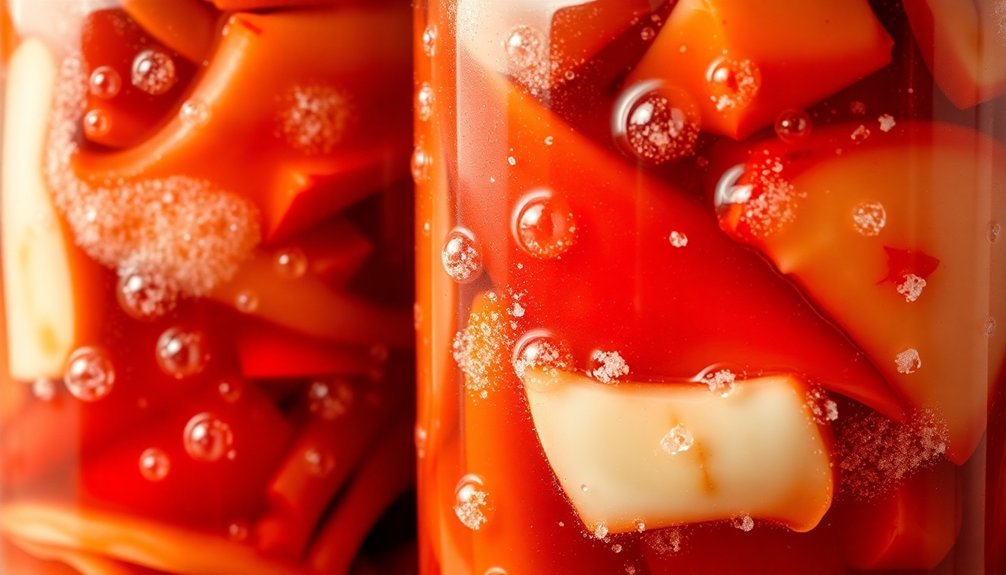
While enjoying the probiotic benefits of kimchi is important, mastering the fermentation process guarantees you'll get consistently great results. You'll need to focus on four key areas: cleanliness, temperature, salting, and monitoring.
Start by maintaining strict hygiene throughout the process. Use fresh, potable water to wash your ingredients thoroughly, removing any soil or contaminants. A clean environment prevents unwanted bacteria from interfering with fermentation.
Temperature control is essential – you'll want to ferment your kimchi at 10°C or lower to prevent harmful bacteria growth. While room temperature fermentation is possible, refrigerated conditions are safer and produce less acid and odor. After 24 hours, storing at -1°C can enhance preferred flavors.
The salting process is equally important. Brine your Chinese cabbage in a 10-12% salt solution for several hours. This draws out moisture and helps seasonings penetrate while supporting beneficial bacteria growth. Your final kimchi should have 2-5% salt concentration.
Monitor the fermentation by checking pH levels regularly – you're aiming for 4.6 or lower. If it doesn't reach this level, you'll need to discard the batch.
Store your finished kimchi in the refrigerator, where it'll stay good for about two months.
Key Bacterial Strains at Work
You'll find three primary lactic acid bacteria strains at work in kimchi: *Leuconostoc*, *Weissella*, and *Lactobacillus*, with *Leuconostoc* leading the initial fermentation phase.
As these bacteria multiply, they produce lactic and acetic acids that lower the pH to around 4.2, creating the signature tangy flavor and preservative environment.
The temperature at which you ferment your kimchi directly impacts which bacterial species dominate, affecting both the fermentation speed and the final flavor profile.
Major LAB Species Types
The remarkable diversity of lactic acid bacteria (LAB) in kimchi fermentation involves five major genera: Leuconostoc, Weissella, Lactobacillus, Pediococcus, and Lactiplantibacillus.
You'll find these bacteria working together in different combinations, depending on the type of kimchi you're making and the fermentation stage.
In traditional cabbage kimchi, you'll notice a fascinating succession of bacterial species. Leuconostoc mesenteroides takes the lead early on, while Latilactobacillus sakei and Levilactobacillus brevis become more prominent as fermentation progresses.
The ingredients you choose and when you make your kimchi will affect which bacteria thrive. For instance, you'll see more Leuconostoc species when fermenting at lower temperatures around 4°C.
Here's what each major bacterial group contributes to your kimchi:
- Leuconostoc mesenteroides produces the essential mix of lactic acid, acetic acid, carbon dioxide, and ethanol
- Lactobacillus plantarum develops unique flavor compounds during fermentation
- Weissella confusa aids in the overall fermentation process
- Latilactobacillus sakei and Levilactobacillus brevis dominate the later stages, perfecting the final taste
Bacterial Growth and Ph
Looking closely at how LAB species operate, we need to understand their growth patterns and pH impact during fermentation. You'll find that lactic acid bacteria begin their work immediately, converting sugars into lactic acid. This conversion causes a rapid pH drop from the initial 5-6 range to the critical safety threshold of 4.6 or lower within 2-6 days at 10°C.
Key LAB strains like _Le. mesenteroides_ and _L. fermentum_ work particularly efficiently, reaching pH 4.4 by day 3. You'll want to monitor this process carefully, as it's vital for eliminating harmful pathogens like _E. coli_ and _Salmonella_.
| Bacterial Strain | Key Characteristics |
|---|---|
| _L. reuteri_ | Superior growth rate, strong acid production |
| _L. fermentum_ | Reaches pH 4.4 by day 3, effective glucose metabolizer |
| _Le. mesenteroides_ | Fast initial fermentation, distinctive flavor profile |
| _Weissella_ | Adaptable to various temperatures, steady acid production |
| Mixed cultures | Enhanced fermentation control, complex flavor development |
Once your kimchi reaches the target pH, you'll need to refrigerate it to stabilize the fermentation and maintain both safety and quality. Regular pH monitoring guarantees your batch meets food safety standards.
Temperature Effects on Bacteria
Temperature control plays a critical role in managing bacterial activity during kimchi fermentation. You'll find that different bacterial strains thrive at specific temperatures, directly impacting your kimchi's flavor and fermentation speed.
At cooler temperatures around 39°F (3.9°C), *Leuconostoc* bacteria dominate the early fermentation stages, creating milder flavors. When temperatures rise to 65°F (18.3°C), *Lactobacillus* species take over, developing more complex taste profiles.
The ideal temperature range for kimchi fermentation falls between 50°F to 70°F (10°C to 21.1°C). Within this range, you'll notice several temperature-dependent effects:
- Warmer temperatures speed up fermentation but may produce excessive carbon dioxide and rushed flavors
- Cooler temperatures slow down the process, allowing for more controlled flavor development
- At 65°F (18.3°C), you'll achieve the most balanced flavor and texture profile
- Refrigeration temperatures around 39°F (3.9°C) considerably slow fermentation for long-term storage
Understanding these temperature effects helps you control the fermentation process. You can adjust the temperature based on whether you want a quick ferment with bold flavors or a slower process with more subtle taste development.
Natural Preservation Through Living Bacteria
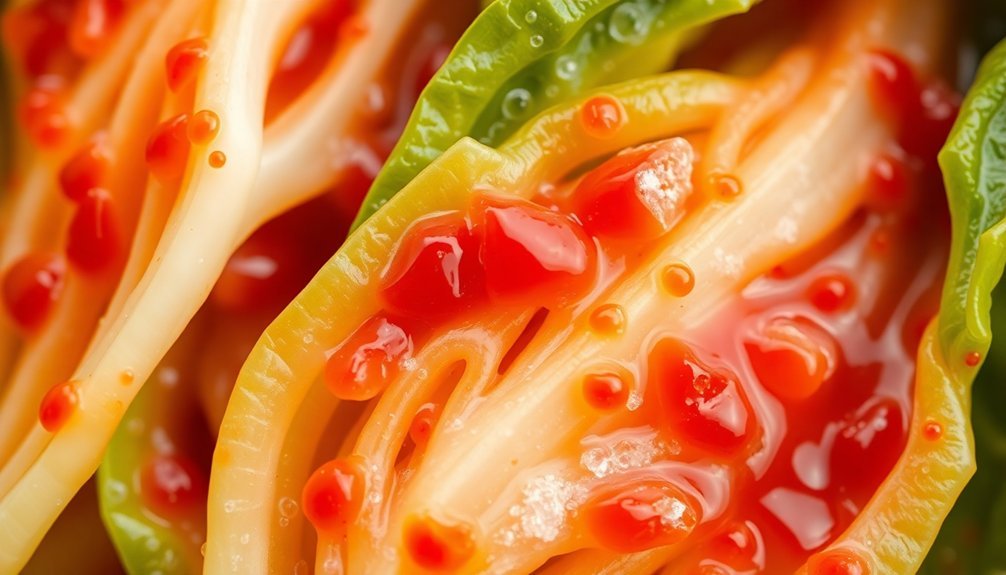
Living bacteria serve as nature's master preservers in the traditional art of kimchi fermentation. When you make kimchi, you're harnessing the power of Lactic Acid Bacteria (LAB) that naturally exist on the vegetables. These beneficial bacteria, including Lactobacillus, Leuconostoc, and Weissella, transform your ingredients by producing lactic acid and carbon dioxide.
You'll find that proper fermentation relies on creating the perfect environment for these bacteria to thrive. The salt concentration of 2-5% draws out moisture and helps seasonings penetrate while supporting LAB growth. As these bacteria digest sugars, they create an acidic environment with an ideal pH of 4.2, effectively preventing harmful organisms from growing.
| Bacterial Type | Primary Function | Key Benefits |
|---|---|---|
| Lactobacillus | Acid production | Preservation |
| Leuconostoc | CO2 generation | Effervescence |
| Weissella | Flavor development | Taste complexity |
| Mixed LAB | Probiotic activity | Health benefits |
These living bacteria don't just preserve your kimchi; they're also creating beneficial compounds that enhance its nutritional value. The fermentation process produces metabolites that contribute to kimchi's anticancer, antiobesity, and immune-promoting properties.
Frequently Asked Questions
Can I Add Probiotics or Starter Cultures to Speed up Kimchi Fermentation?
Yes, you can add starter cultures or probiotics to speed up kimchi fermentation. While traditional kimchi ferments naturally, using these cultures will accelerate the process and help guarantee more consistent results.
Why Does My Kimchi Sometimes Develop a White Film on Top?
Your kimchi's white film likely appears due to insufficient brine coverage, wrong storage temperature, or poor salt balance. Make sure your kimchi's fully submerged, stored at proper temps, and has enough salt.
Is It Safe to Eat Kimchi if Bubbles Form During Fermentation?
Yes, it's completely safe to eat kimchi with bubbles. They're actually a good sign, showing that beneficial lactic acid bacteria are actively fermenting your kimchi. These bubbles indicate proper fermentation is occurring.
How Can I Tell if My Kimchi Has Gone Bad?
You'll know your kimchi has gone bad if you notice excessive mushiness, dark spots, mold growth, or an off-putting smell. If it tastes unpleasantly sour or has a rotten odor, don't eat it.
Should I Wash Kimchi Cabbage With Tap Water or Filtered Water?
You can use either tap or filtered water to wash your kimchi cabbage. Both are fine as long as your water source is clean. What's most important is thoroughly rinsing to remove dirt and excess salt.
In Summary
You've discovered that living bacteria aren't just helpful but essential for creating authentic kimchi. Without these microscopic workers, you won't get the complex flavors, preservation benefits, and probiotic goodness that make kimchi special. Understanding how lactic acid bacteria transform simple ingredients into this fermented superfood lets you appreciate why your kimchi needs to stay alive and active to maintain its unique characteristics.

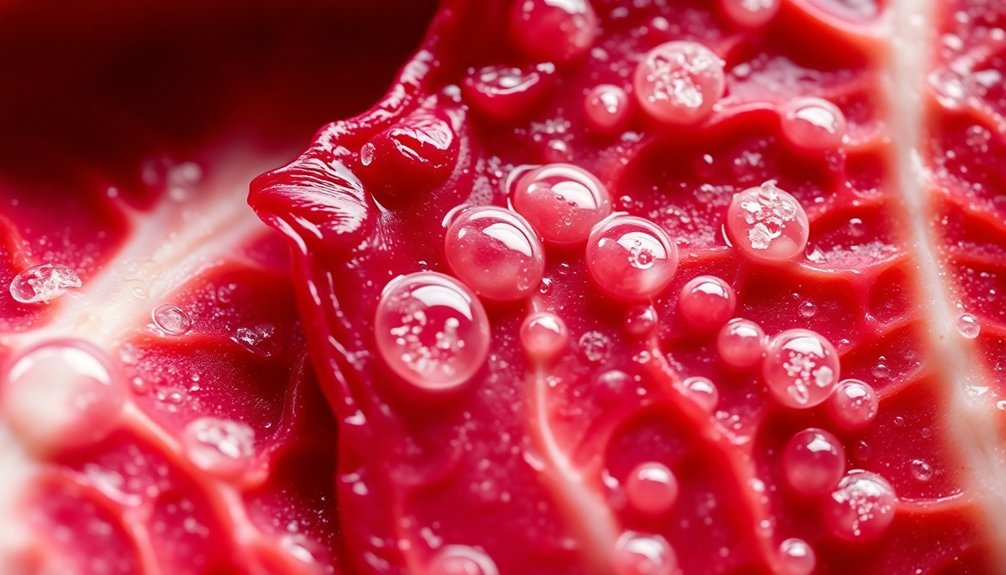



Leave a Reply